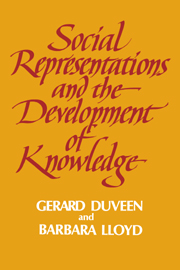Book contents
- Frontmatter
- Contents
- List of figures
- List of tables
- List of contributors
- Acknowledgements
- 1 Introduction
- 2 The underlife of the nursery school: young children's social representations of adult rules
- 3 A semiotic analysis of the development of social representations of gender
- 4 Children's representations of social relations
- 5 Social representations of childhood: an implicit theory of development
- 6 What is in an image? The structure of mothers' images of the child and their influence on conversational styles
- 7 The acquisition of reflexive social emotions: the transmission and reproduction of social control through joint action
- 8 From social cognition to social representations in the study of intelligence
- 9 Prototypes of the psychologist and professionalisation: diverging social representations of a developmental process
- 10 Social psychology and developmental psychology: extending the conversation
- Author index
- Subject index
4 - Children's representations of social relations
Published online by Cambridge University Press: 08 March 2010
- Frontmatter
- Contents
- List of figures
- List of tables
- List of contributors
- Acknowledgements
- 1 Introduction
- 2 The underlife of the nursery school: young children's social representations of adult rules
- 3 A semiotic analysis of the development of social representations of gender
- 4 Children's representations of social relations
- 5 Social representations of childhood: an implicit theory of development
- 6 What is in an image? The structure of mothers' images of the child and their influence on conversational styles
- 7 The acquisition of reflexive social emotions: the transmission and reproduction of social control through joint action
- 8 From social cognition to social representations in the study of intelligence
- 9 Prototypes of the psychologist and professionalisation: diverging social representations of a developmental process
- 10 Social psychology and developmental psychology: extending the conversation
- Author index
- Subject index
Summary
Introduction
How do children make sense of social relationships? How do they represent the various transactions and exchanges that characterise the social life around them? How does their knowledge differ from that of the adults in their community and, perhaps the most fundamental question, what is the process by which this social knowledge develops? It might be argued that developmental psychology has now provided much of the answer to such questions. In this chapter we hope to persuade you that such a conclusion would be premature. To this end we shall argue that the theory of social representations generates a distinctive view of the development of social knowledge, one which is in several important respects at variance with the prevailing cognitive constructivist interpretation of much current developmental psychology. Our argument and examples will concentrate on the period of middle childhood, roughly from seven to thirteen years. And we will consider the knowledge children in this period express with respect to two specific domains: relations involving formal authority, and wage relations.
The Piagetian revolution
Until the mid 1960s, most psychology texts equated ‘social development’ with ‘socialisation’. Socialisation was about the process by which a child is turned into a non-disruptive, conforming member of a particular culture. There was little serious interest in the possibility that to become an effective performer in society, the child would also need in any sense to understand how that society or any aspect of it functioned. Under Piaget's influence, this view began to change. Today there is little dispute that children do think about the nature of the social world they inhabit.
- Type
- Chapter
- Information
- Social Representations and the Development of Knowledge , pp. 47 - 69Publisher: Cambridge University PressPrint publication year: 1990
- 17
- Cited by



